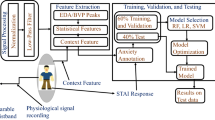Abstract
Anxiety can manifest through a range of physiological changes. We develop methods to detect anxiety among medical residents making case presentations in a clinical setting using wearable sensors and machine learning. A number of classifiers are tested on different features extracted from real-time physiological measurements. Our results indicate that anxiety can be detected among healthy volunteers in clinical setting and serve as an introduction to future wearable sensing studies for applications in radiation oncology.
M. Gray and S. Majumder—These authors contributed equally to this work.
Access this chapter
Tax calculation will be finalised at checkout
Purchases are for personal use only
Similar content being viewed by others
Notes
- 1.
The variation in electrical conductance of the skin due to sweat secretion.
- 2.
References
Thayer, J.F., Åhs, F., Fredrikson, M., Sollers, J.J., Wager, T.D.: A meta-analysis of heart rate variability and neuroimaging studies: implications for heart rate variability as a marker of stress and health. Neurosci. Biobehav. Rev. 36(2), 747–756 (2012). https://doi.org/10.1016/j.neubiorev.2011.11.009
Ollander, S., Godin, C., Campagne, A., Charbonnier, S.: A comparison of wearable and stationary sensors for stress detection. In: 2016 IEEE International Conference on Systems, Man, and Cybernetics (SMC), Budapest, Hungary, pp. 004362–004366, October 2016. https://doi.org/10.1109/SMC.2016.7844917
Understanding the stress response - Chronic activation of this survival mechanism impairs health. Harvard Health Online, March 2011
Lee, H., Kleinsmith, A.: Public speaking anxiety in a real classroom: towards developing a reflection system. In: Extended Abstracts of the 2019 CHI Conference on Human Factors in Computing Systems, Glasgow, Scotland, UK, pp. 1–6, May 2019. https://doi.org/10.1145/3290607.3312875
Choi, B., Jebelli, H., Lee, S.: Feasibility analysis of electrodermal activity (EDA) acquired from wearable sensors to assess construction workers’ perceived risk. Saf. Sci. 115, 110–120 (2019). https://doi.org/10.1016/j.ssci.2019.01.022
Oskooei, A., Chau, S.M., Weiss, J., Sridhar, A., Martínez, M.R., Michel, B.: DeStress: deep learning for unsupervised identification of mental stress in firefighters from heart-rate variability (HRV) data. arXiv:1911.13213 [cs, eess, stat], November 2019. Accessed 10 Nov 2020
Fuentes-García, J.P., Clemente-Suárez, V.J., Marazuela-Martínez, M.Á., Tornero-Aguilera, J.F., Villafaina, S.: Impact of real and simulated flights on psychophysiological response of military pilots. IJERPH 18(2), 787 (2021). https://doi.org/10.3390/ijerph18020787
Carreiro, S., Chintha, K.K., Shrestha, S., Chapman, B., Smelson, D., Indic, P.: Wearable sensor-based detection of stress and craving in patients during treatment for substance use disorder: a mixed methods pilot study. Drug Alcohol Depend. 209, 107929 (2020). https://doi.org/10.1016/j.drugalcdep.2020.107929
Delmastro, F., Martino, F.D., Dolciotti, C.: Cognitive training and stress detection in MCI frail older people through wearable sensors and machine learning. IEEE Access 8, 65573–65590 (2020). https://doi.org/10.1109/ACCESS.2020.2985301
Can, Y.S., Arnrich, B., Ersoy, C.: Stress detection in daily life scenarios using smart phones and wearable sensors: a survey. J. Biomed. Inform. 92, 103139 (2019). https://doi.org/10.1016/j.jbi.2019.103139
McGinnis, R.S., et al.: Rapid anxiety and depression diagnosis in young children enabled by wearable sensors and machine learning. In: 2018 40th Annual International Conference of the IEEE Engineering in Medicine and Biology Society (EMBC), Honolulu, HI, pp. 3983–3986, July 2018. https://doi.org/10.1109/EMBC.2018.8513327
Shaffer, F., Ginsberg, J.P.: An overview of heart rate variability metrics and norms. Front. Public Health 5, 258 (2017). https://doi.org/10.3389/fpubh.2017.00258
“Empatica Support,” E4 Wristband Data, 23 January 2020. https://support.empatica.com/hc/en-us/sections/200582445-E4-wristband-data
Jones, D.: The Blood Volume Pulse - Biofeedback Basics, 10 May 2018. https://www.biofeedback-tech.com/articles/2016/3/24/the-blood-volume-pulse-biofeedback-basics
Johnson, D.: We Are Expected To Be Public Speakers, But Never Taught, 02 April 2019. https://opmed.doximity.com/articles/we-are-expected-to-be-public-speakers-but-never-taught?csrf attempted=yes
Kavanagh, J.: Giving presentations without palpitations. BMJ 332(7555), s242–s243 (2006). https://doi.org/10.1136/bmj.332.7555.s242
Tejwani, V., Ha, D., Isada, C.: Observations: public speaking anxiety in graduate medical education-a matter of interpersonal and communication skills? J. Grad. Med. Educ. 8(1), 111 (2016). https://doi.org/10.4300/JGME-D-15-00500.1
“Empatica Support,” Utilizing the PPG/BVP signal, 23 January 2020. https://support.empatica.com/hc/en-us/sections/200582445-E4-wristband-data
Welch, P.: The use of fast Fourier transform for the estimation of power spectra: a method based on time averaging over short, modified periodograms. IEEE Trans. Audio Electroacoust. 15(2), 70–73 (1967). https://doi.org/10.1109/TAU.1967.1161901
Univariate feature ranking for classification using chi-square tests. MATLAB (2021)
Gajawada, S.: “Towards Data Science,” Chi-Square Test for Feature Selection in Machine learning. https://towardsdatascience.com/chi-square-test-for-feature-selection-in-machine-learning-206b1f0b8223
Gjoreski, M., Luštrek, M., Gams, M., Gjoreski, H.: Monitoring stress with a wrist device using context. J. Biomed. Inform. 73, 159–170 (2017). https://doi.org/10.1016/j.jbi.2017.08.006
Shaukat-Jali, R., van Zalk, N., Boyle, D.E.: Detecting subclinical social anxiety using physiological data from a wrist-worn wearable: small scale feasibility study. JMIR Formative Res. 5(10) (2021). https://doi.org/10.2196/32656
Mozos, O.M., Sandulescu, V., Andrews, S., et al.: Stress detection using wearable physiological and sociometric sensors. Int. J. Neural Syst. 1–17 (2005). https://core.ac.uk/reader/76958656?utm source=linkout
Betti, S., Lova, R.M., Rovine, E., et al.: Evaluation of an integrated system of wearable physiological sensors for stress monitoring in working environments. IEEE Trans. Biomed. Eng. 65(8), 1748–1758 (2018). https://doi.org/10.1109/TBME.2017.2764507
Arsalan, A., Majid, M.: Human stress classification during public speaking using physiological signals. Comput. Biol. Med. 133, 10437 (2021). https://doi.org/10.1016/j.compbiomed.2021.104377
James, G., Witten, D., Hastie, T., Tibshirani, R.: An Introduction to Statistical Learning: with Applications in R, 2nd edn., pp. 227–250. Springer, New York (2022). https://doi.org/10.1007/978-1-4614-7138-7
Acknowledgment
We would like to thank Dr. David Wazer, Dr. Elana Nack, Dr. Imran Chowdhury and Dr. Jeff Huang for their support.
Author information
Authors and Affiliations
Corresponding author
Editor information
Editors and Affiliations
Rights and permissions
Copyright information
© 2022 Springer Nature Switzerland AG
About this paper
Cite this paper
Gray, M., Majumder, S., Nelson, K., Munbodh, R. (2022). Detecting Anxiety Trends Using Wearable Sensor Data in Real-World Situations. In: Bowles, J., Broccia, G., Pellungrini, R. (eds) From Data to Models and Back. DataMod 2021. Lecture Notes in Computer Science, vol 13268. Springer, Cham. https://doi.org/10.1007/978-3-031-16011-0_8
Download citation
DOI: https://doi.org/10.1007/978-3-031-16011-0_8
Published:
Publisher Name: Springer, Cham
Print ISBN: 978-3-031-16010-3
Online ISBN: 978-3-031-16011-0
eBook Packages: Computer ScienceComputer Science (R0)




